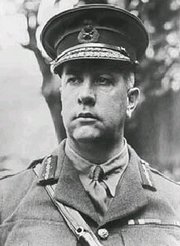Arthur Currie
|
|
General Sir Arthur William Currie (December 5, 1875 - November 30, 1933) was the first Canadian commander of the Canadian Corps on the Western Front during World War I and one of the most successful Allied generals of the war and in Canadian history.
Under his capable leadership the Canadian Forces won a long series of battles, fighting as an independent national command for the first time in a major war and earning a fierce reputation as among the most effective Allied troops.
Arthur Currie was born in Napperton, Ontario and attended Strathroy Collegiate Institute in Strathroy, Ontario. In 1894 he moved to Victoria, British Columbia where he first taught school and later sold real estate. There, he joined the army militia and over the years prior to the Great War rose through the ranks to become his regiment's Commanding Officer. With Garnet Hughes, son of the Canadian minister of militia Sam Hughes, he was sent to Europe upon the outbreak of the First World War in 1914. He commanded a brigade at the Second Battle of Ypres in 1915 and by 1917 he had been promoted to general, the first Canadian to receive this honour during the war.
Currie was often vehemently opposed to General Douglas Haig, the senior British commander who was his superior officer and who had the overall command of the British, Canadian, and other colonial troops. Haig insisted on sending wave after wave of men into certain death; Currie did his best to win battles with minimal Canadian casualties, in opposition to this costly strategy of attrition.
With General Julian Byng, Currie was largely responsible for the tactics and careful planning which led to an unexpected triumph by Canadian forces at the Battle of Vimy Ridge in April, 1917. One of the most useful innovations introduced at this battle was the creeping barrage, which consisted of troops walking just behind an advancing line of shell fire from Canadian artillery, shielding soldiers as they approached the Germans. In addition, constant practice and new troop organization in which each platoon member was trained to carry out all platoon responsibilities, briefing of the frontline troops, the use of counter-battery fire measures and constant patrolling of the enemy defenses all contributed to the effectiveness of the Canadian army at Vimy and for the rest of the War. Currie and the Canadian Corps were successful again at Passchendaele (the Third Battle of Ypres) in November, but at the cost of 16,000 men. Currie had accurately predicted these high casualty figures when Haig ordered his troops to attack.
At Canal du Nord in September of 1918, Currie flatly refused to carry out Haig's orders to attack across a canal and into a fortified German trench. With the support of General Byng, Currie had bridges quickly assembled and crossed the canal at night, surprising the Germans with an attack in the morning. This proved the effectiveness of Canadian engineers, for whom Haig had no use. Currie believed in the specialization of troops and formally organized battalions of combat engineers to move with the troops. As the war neared its end, the Canadian forces pressed on towards Germany, strengthening their reputation as one of the most feared and respected armies of the war in Canada's Hundred Days which included the Battle of Amiens from August 8-11, 1918.
The last Canadian casualty of World War I, George Lawrence Price, died under Currie's command at Mons just before the 11:00am Armistice on November 11, 1918.
Currie was respected by his soldiers as a competent general who would not waste their lives needlessly, but he was not well-liked as he was considered too arrogant. However, because of his unorthodox tactics and his frequent refusals to follow traditional strategies favoured by his British superiors, Currie was disliked as a general by Sam Hughes, who frequently attempted to have him removed. Currie also refused to allow his former friend Garnet Hughes to serve under him, because of what Currie perceived to be incompetence when they fought together in at Ypres in 1915. This also did not endear him to Garnet's father.
Currie, along with General John Monash of Australia, were both civilians who during the War came to lead their respective armies in war. It it said by many that they were not bound by British military traditions and Victorian class structures, and were able to develop organizations and tactics that reflected the colonial cultural from which they came.
Currie was also involved in a scandal stemming from his time in Victoria just before the war began. He defrauded his regiment of $10,000 to buy new uniforms, which came to light in 1917; however Prime Minister Robert Laird Borden did not wish to disgrace a war hero and let the matter drop.
After the war Currie became President of McGill University in Montreal in 1920. His legacy at the university remains in the Currie Gym and the Montreal Neurological Institute under William Penfield. At the Royal Military College of Canada there is a building named for Currie as well as a memorial hall. In Calgary until recently there were the Currie barracks.
In 1928 a newspaper in Cobourg, Ontario reported that Sam Hughes had accused Currie of being just as much of a "butcher" as General Haig. Currie sued the newspaper for libel and won the case.
He was knighted in 1917, and also honoured with the British Order of the Bath, Knight Commander of the Order of St. Michael and St. George, the French Légion d'honneur and Croix de Guerre, and the U.S. Distinguished Service Medal.
Gen. Currie died soon after the 15th anniversary of the Armistice, on November 30, 1933. He is interred in the Mount Royal Cemetery in Montreal, Quebec.

